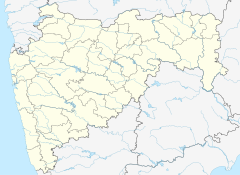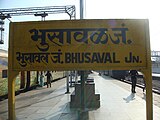Bhusaval Junction railway station
Bhusaval Junction | |||||||||||||||
|---|---|---|---|---|---|---|---|---|---|---|---|---|---|---|---|
| Indian Railways junction station | |||||||||||||||
 Indian Railways logo | |||||||||||||||
| General information | |||||||||||||||
| Location | Bhusawal, Maharashtra, PIN 425201 India | ||||||||||||||
| Coordinates | 21°02′49″N 75°47′17″E / 21.0469°N 75.788°E | ||||||||||||||
| Elevation | 205.030 metres (672.67 ft) | ||||||||||||||
| Owned by | Indian Railways | ||||||||||||||
| Operated by | Central Railway | ||||||||||||||
| Line(s) | Howrah–Nagpur–Mumbai line Howrah–Prayagraj–Mumbai line Nagpur–Bhusawal section Bhusawal–Kalyan section Jabalpur–Bhusaval section | ||||||||||||||
| Platforms | 9 | ||||||||||||||
| Construction | |||||||||||||||
| Structure type | At ground | ||||||||||||||
| Parking | Available | ||||||||||||||
| Other information | |||||||||||||||
| Status | Active | ||||||||||||||
| Station code | BSL | ||||||||||||||
| Division(s) | Bhusawal | ||||||||||||||
| History | |||||||||||||||
| Opened | 1860 | ||||||||||||||
| Electrified | 1968–69 | ||||||||||||||
| Services | |||||||||||||||
| |||||||||||||||
| Location | |||||||||||||||
 | |||||||||||||||
Bhusawal Junction railway station (formerly Bhosawal) serves Bhusawal in Jalgaon district of the Indian state of Maharashtra. Bhusawal railway station is one of the top-100 booking stations of Indian Railways.[1] Approximately fourteen trains originate at Bhusawal station with 289 trains servicing the railway stop.[2]
History[edit]
Bhusawal railway station was formally established in 1863.[3] In 1866, the Great Indian Peninsula Railway (GIPR) branch line was extended to Khandwa and then to Nagpur in 1867. Bhusawal is a divisional headquarters under Central Railways.[4] Bhusawal railway station was built by the then British-run Indian government at a sum of £80,000 (8,00,000 Indian rupees) from 1852 to 1865. The station was built with a large bath, refreshment rooms, a large workshop, dwellings for European employees, reading rooms and gymkhana. The Bhusawal railway line was opened between 1861 and 1865.[5]
Electrification[edit]
Railways in the Bhusawal area were electrified in 1968–69. Like other lines, the railway is powered by a single-phase, 25 kV AC supply.[6]
Amenities[edit]
Amenities at Bhusawal railway station include an SBI ATM, reservation office, STD/PCO booth, waiting room, retiring room, vegetarian and non-vegetarian refreshments, information desk, post office, Wi-Fi, and more.[7] The northern and southern entrances have separate ticketing windows. There is a free 4-wheeler parking area at the northern entrance. Bhusawal railway station and ST stand. Elevators and electric vehicles are available for use by railway station passengers.
Locomotive shed[edit]
The locomotive shed at Bhusawal was established by GIPR in 1919. At that time, it was the largest in Asia and the third-largest in the world.[8] The Electric Locomotive Workshop at Bhusawal was established in 1974 at a cost of ₹3.52 crores and performs periodical overhauls of electric locomotives. It is also the only workshop in India to perform overhauls of three-phase, induction motor-based trains.[9]
Bhusawal Locomotive Shed has been accredited with the International Standard Certificate ISO 9008-2000 since April 2006.
The shed has WAM-4, WAP- 4, WAG-5, and WAG-9 locomotives.
Gallery[edit]
-
Bhusawal Junction
References[edit]
- ^ "Indian Railways Passenger Reservation Enquiry". Availability in trains for Top 100 Booking Stations of Indian Railways. IRFCA. Archived from the original on 10 May 2014. Retrieved 2012-11-21.
- ^ "Bhusawal Jn railway station details". iniantrains.org. Archived from the original on 29 June 2013. Retrieved 13 March 2013.
- ^ "The Gazetteers Dept Maharashtra". Government of Maharashtra. Retrieved 22 July 2014.
- ^ "IR History: Early Days – I : Chronology of railways in India, Part 2 (1832–1865)". IRFCA. Retrieved 8 March 2013.
- ^ Campbell, James (1880). Gazetteer of Bombay presidency : Khandesh. Bombay,India: British India governmentat. p. 1.
- ^ "History of Electrification". IRFCA. Retrieved 8 March 2013.
- ^ "Bhusaval Railway Station Map". Retrieved 29 May 2020.
- ^ "IR History: Part III (1900–1947)". IRFCA. Retrieved 13 March 2013.
- ^ "Central Railway / Indian Railways Portal". Retrieved 29 May 2020.


